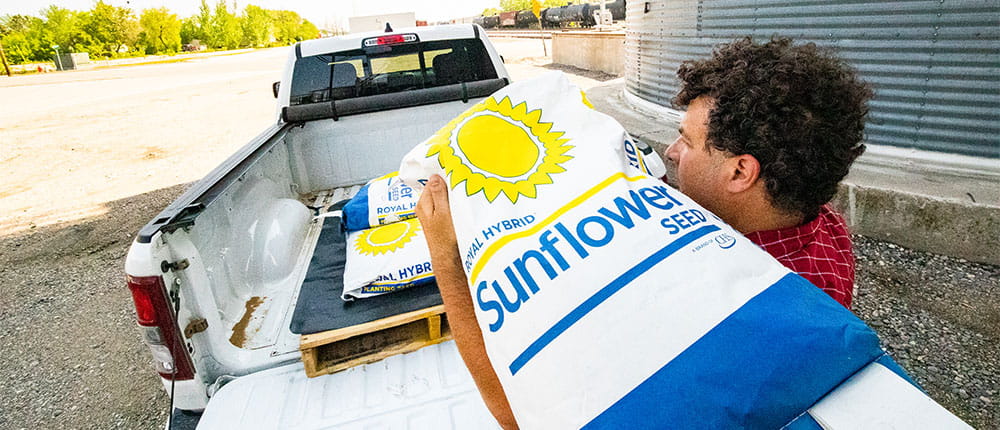Lift. Turn. Lift. Turn. Ouch!
“It only takes one improper lift to put you out of service,” says Matt Surdick, a senior manager for environmental health and safety with CHS.
Moving heavy equipment, repetitive maintenance tasks and long days in the combine call for extra care to avoid pain and injury.
Control these injury risk factors
Nationwide lists these risk factors for pain and injury caused by tasks on the farm or ranch:
- Force: Lifting or moving heavy objects can lead to muscle strain or back injury.
- Repetition: Repeated movements can lead to muscle fatigue injuries. Watch out for extreme stretching or awkward body positioning.
- Posture: Standing or sitting in one position for long periods can lead to back injury or stiff muscles.
- Stress: External pressures and mental stress contribute to muscle tension and tightness, which can cause pain and trigger other injuries.
Find practical farm-focused health tips at AgriSafe.
“Everyone wants to hit the ground running, but working through fatigue and stress puts strain on bodies,” says Surdick. “Make sure your body is ready to go when the busy season starts.”
Working smarter, not harder, is the best approach, says Vickie Kilgore, a senior risk management consultant in health and safety for Nationwide, one of the largest ag insurance providers in the U.S.
“If you lift something 10 times a day, can you set it up higher so you don’t have to reach down to the floor? A change as simple as setting something on a five-gallon bucket can make an amazing difference in how you feel at the end of the day. There are lots of easy fixes,” she adds, “if you’re aware and have a plan. Brainstorm about how things could be done differently to avoid injury and find ways to make the work easier.”
Every body is different
“We use our bodies as tools,” says Linda Emanuel, registered nurse and community health director with AgriSafe Network, a national nonprofit organization that helps health and safety professionals build skills to deliver effective health care to ag professionals. “That can take a toll over time and lead to shoulder strains, rotator cuff tears, tendonitis, carpal tunnel syndrome, lower back pain and more. You might start to feel discomfort but decide to grind through it. Eventually, the pain can become overwhelming and interrupt normal activities.”
Understanding and accommodating for each person’s physical capabilities and skill set is a key factor in avoiding injury, says Kilgore.
“Consider what you and others can do safely and for extended periods of time, if required. Sometimes that means being honest with yourself and saying, ‘That’s not a job I’ll do anymore.’”
“We all work differently and our needs are different,” agrees Emanuel. “That could mean spacing out activities throughout the day and resting between activities.
“As we age, we tend to tire more easily and lose strength and endurance, which affects the kind of activities you can handle,” she adds, “especially when you factor in heat and other weather conditions.”
Communication is the key to understanding and meeting the needs of everyone at work in the operation, Emanuel says. “Open conversations about working safely and setting an example can make all the difference. A healthy farmer is a safe farmer.”
Working smart tips
Surdick, Kilgore and Emanuel offer the following tips to help avoid injury and downtime.
Warm up
“You wouldn’t run a race without warming up, so you shouldn’t start a task without doing some stretching, including shoulder rolls and hamstring stretches,” says Surdick. “Safe lifting starts with getting your body ready.”
Plan ahead
“Think about what you’re going to lift and where you’ll put it,” Surdick advises. Avoid pivoting while carrying a heavy weight to reduce strain on your back.
Clear the path
Remove obstacles that block sightlines or could be tripping hazards. Look for help. “Determine whether you need a second person — or equipment — to help with lifting,” says Surdick. “Trying to muscle through it alone could be the wrong approach.”
Lift properly
Lift with your legs and keep objects close to your body while lifting and carrying. Look for handles to make lifting easier. Shoveling is lifting, too — keep shovelfuls small and manageable.
Stay focused
“Be conscious of your body’s center of gravity at all times,” says Emanuel. “Reminding yourself to stand up straight helps maintain alignment to prevent injury.”
Stay hydrated and eat well
Emanuel suggests starting the day with water and keeping a water jug nearby throughout the day. A healthy diet provides fuel for strength and helps manage stress.
Switch it up
“Standing or sitting for long periods of time is your enemy,” says Kilgore. She recommends rotating tasks and taking planned breaks. A 30-second timeout every 15 minutes or climbing out of the cab for five to 10 minutes every two hours lets you stretch, move or relax to help reduce muscle fatigue.
Set up shop
Kilgore recommends choosing hand tools with handles that are four to five inches long and have comfortable, slip-resistant grips that fit your hand. Other suggestions include having tools organized and at arm’s reach; standing on an antifatigue mat; wearing comfortable, supportive boots or shoes; and choosing well-fitting work gloves for safety and to avoid hand fatigue.
Get some rest
“I can’t stress enough the need for seven to nine hours of quality sleep every night,” Emanuel says. “Being overtired contributes to accidents while operating equipment and affects balance, which can lead to slips, trips and falls. Know when to end the day.”
Make conditioning a year-round activity
“Commit to daily stretching and strengthening your core,” says Emanuel. “You want to condition your muscles to be ready for the busy season.”




